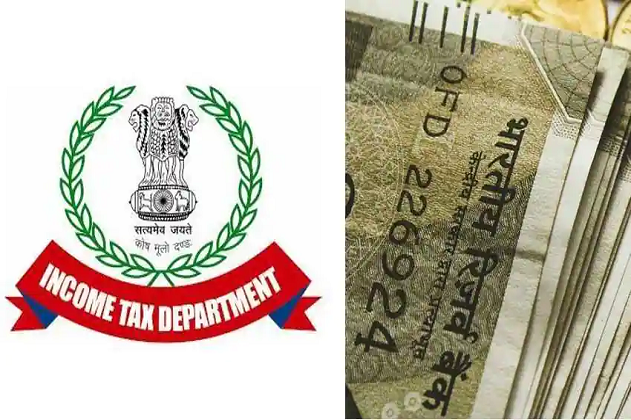Income Tax Update: Taxpayers have to pay tax as per the income tax slab and if they do not do so, they get a notice from the income tax department. There are not only 1 or 2 notices from the income tax department (Income Tax notice news), but there are 8 types of notices. These different types of notices are used in different situations. Most people are also unaware of the time taken to respond to the notice. Let us know how much time is given to respond to these notices.
Income Tax Rules: Notices related to the Income Tax Department can be a cause of concern for everyone. Often people think that there are only one or two types of notices, but in reality there are 8 different types of income tax notices. The purpose of these notices is to resolve various tax-related issues and get the correct information. However, there is a fixed time limit to respond to these notices (Income Tax notice update), which is very important for every taxpayer to understand. If the answer is not given on time, then the problems may increase.
This is why the Income Tax Department sends notices –
If there is any mistake in the Income Tax Return (ITR) of a person, then the tax department can send him a notice. This information is based on whether the information has been given incorrectly or any important facts have been left out. On receiving such a notice (Income tax notices), the department investigates the situation and takes action if needed. It is important that the person understands the reasons for such a notice, so that the correct answer can be given. In some cases, this notice can also be received by a salaried person, when an error is found in their details. Through these notices, the department conducts its investigation and directs to take correct action.
1. Section 143(1)(a) Tax Notice –
When the Income Tax Department has processed the tax return filed by you, it sends a message called an Intimation Notice (Intimation Under Section 143(1) of Income Tax Act). This message confirms whether there is any discrepancy between the information provided by you and the calculations made by the department.
If there is any discrepancy between the two, the reason for the same is also mentioned in this message. The purpose of this process is to ensure that the information provided by you is correct and matches the calculations of the department. This message (Section 143(1)(a) tax notice) is sent to inform about the correctness of the tax liability and any mistake.
Reasons for sending intimation notice –
143(1) Mismatch intimation notice can be sent when there is a mistake in filing the return, or there is a difference between the calculations done by the department and your information. This difference can be due to mistake in calculation, wrong claims, arithmetical errors, wrong calculation of interest under section 234A/B/C, or mismatch of information with Form 26AS.
This notice can also be received when the return is filed in response to a notice sent by the department. Apart from this, this message is issued when the return of a taxpayer does not match the calculations of the department (ITR calculation). Due to these reasons, the taxpayer may receive a notice based on incorrect information or wrong calculations.
Time limit to respond to intimation notice –
If there is no discrepancy between the information provided by you and the department’s calculation, or the notice is issued because of a refund, you need not respond. However, if there is a discrepancy, you need to take action. If you receive an intimation under section 143(1)(A) then you need to respond within 30 days from the date of the notice. It is important to take appropriate steps within this time limit to avoid any issues and to follow the correct procedure. Timely response is important for the taxpayer to avoid any misunderstanding or penalties.
2. Section 139 (9) Defective ITR Notice –
If you have submitted your tax return with incorrect or incomplete information, the Income Tax Department can send you a notice under Section 139 (9). This notice is issued when there is a mistake in the form, such as selecting the wrong form or lack of necessary information. Apart from this, if there is any deficiency in documents or details, then the return can also be considered defective. Through such a notice, the department tells you that your information is not complete and you have to correct it. The purpose of this notice is to make the return correct and move the processes in the right direction.
This notice comes for this reason –
If you have given any wrong information in your tax return, then you can get a Defective ITR Notice. For example, if you have claimed HRA, but your salary breakup does not include HRA, then this can be a common reason. Apart from this, if you have claimed TDS but have not given information about the related income, then such a notice can also be sent. For example, if you did not give information about the interest on FD, but claimed the TDS deducted on the same FD, then this can also be a reason.
To correct such a mistake, it is necessary for you to respond to the notice (types of IT notice). This notice can be sent within nine months from the end of the financial year in which you have filed your return. For example, if you have filed a return (ITR Defective notice) for the financial year 2023-24, then this notice can be issued on or before December 31, 2025. Within this time limit, if the department finds any mistake or deficiency in your return, then you can send a notice.
You can make corrections in this time –
If your return is found to be defective, you will get 15 days from the date of notice (IT defective notice reply time) or a chance to correct it within the time limit given in the notice. If the time limit is not enough for you, you can apply for its extension. This process gives you time to make corrections and provide correct information, so that there is no problem in your return.
3. Section 142(1) Tax Notice
Notice under section 142(1) is issued in the form of an inquiry. It is called Assessment Notice (Notice Under Assessment or Reassessment). It is sent when a person does not file his ITR under section 139(1). Through this notice, the Income Tax Department urges the person to file the return. It is sent before the assessment or reassessment notice, so that the person can submit his information to the department in the right manner.
For what reason is assessment notice sent –
This notice is issued when the Income Tax Department wants to know why you did not file the return despite your income being above the exemption limit. The department needs clarification on the return submitted by you (Income tax return news), to ensure that your income and expenses are correct. You have to answer all the questions asked in this notice correctly and provide the necessary documents and information to prove your claims.
Time limit for assessment notice –
There is no time limit for such a notice, so it can be issued at any time. Taxpayers are required to respond within the time limit given in the notice, which is usually 15 days. It is necessary to provide correct information and documents within this time limit.
4. Scrutiny assessment notice –
The notice sent under section 143(2) is called a scrutiny assessment notice. This notice is issued when the Income Tax Department wants to thoroughly examine the ITR filed by you. The department verifies the veracity of all the claims made by you, such as information about your income and deductions. The purpose of this notice is to ensure that the taxpayer has given correct information about his income and expenses and no wrong claims have been made. Before sending it, the department thoroughly reviews the return to detect any mistake or incorrect information.
Reason for sending scrutiny assessment notice –
The purpose of this notice is to conduct a thorough investigation of the return submitted by the taxpayer. When the tax department has to verify the veracity of claims, deductions and other information made by a taxpayer, a notice is sent to him under section 143(2). This is a detailed investigation called scrutiny assessment. The department wants to ensure that the information provided by the taxpayer is correct and valid. If any error or wrong claim is found, the department takes necessary steps to correct it.
Reply Time for Scrutiny Assessment Notice –
Usually 15 days time is given to respond to this notice (reply Time for scrutiny assessment notice). However, the time limit given in the notice is preferred. On receiving the notice, you have to submit the reply by uploading your information and documents correctly. It is important to ensure that all the required documents are submitted correctly and completely to avoid any kind of problem.
5. Notice under Section 148 –
Section 148 is used when a person’s income is left out of the previous year’s assessment. In this case, if the assessing officer (AO) finds evidence that the income has not been filed correctly, he issues this notice. Before the department asks for reasons for re-assessment, a notice is first sent under Section 148A. This notice (Notice under Section 148 of Income Tax Act) is to obtain information about why this income was not re-examined and why it should be included in the re-assessment.
Reason for notice under section 148 –
After receiving a response from the taxpayer or in the absence of a response, the Income Tax Department issues an order. This order clarifies whether the case is fit for re-assessment or not. This order is passed under section 148A(d) (IT section 148D) to determine whether the taxpayer’s income has been assessed correctly or not. Through this order, the department decides whether to start the process of re-assessment or not, and takes necessary action related to it.
The department has the right to re-assess –
This notice can be issued within a certain time limit under section 148. If the income missed in the relevant year is less than Rs 50 lakh, then this notice can be issued within 3 years 3 months. On the contrary, if the income is more than Rs 50 lakh, then the notice for the relevant assessment year can be issued up to 5 years 3 months. Within this time limit, the department has the right to re-assess and check the correct status of the income. This provision is to ensure the real status of the income, so that any kind of tax evasion can be prevented.
Time to reply to notice received under section 148 –
Taxpayers are required to reply to the notice within the prescribed time limit. The time limit to reply to this notice is generally 1 month (Reply time for notice in section 148). In this period, you are required to provide correct information and documents in response to the notice.
6. Notice under section 245 –
Notice can be sent under the provision of section 245. Let us tell you that the Income Tax Department can adjust the previous year’s pending tax with the current year’s refund. This adjustment is done only when there is a tax refund or tax left in the current year. The purpose of the department is to meet the old dues with the new refund, so that the tax accounts of both the years can be balanced and there is no additional payment.
This notice can be issued when the previous year’s pending tax is pending and it has not been paid or settled. There is no specific time limit for this, that is, this notice can be sent at any time. If for some reason the outstanding tax has not been paid, then the department can start the process of settling the tax through this notice.-
Response has to be given within this time –
There is usually a time limit of 30 days (Intimation notice reply time) to respond to this notice sent under section 245. If you have any objection to this notice or you have already paid the due amount, then you have to provide proof of tax payment in your reply. This time limit and documents help to clarify the status of the case for the department, so that they can take the right decision.-
7. Notice can come under section 154 –
If any error is found in a claim after the Income Tax Authority accepts the return, then the department can issue a notice under section 154. This notice is to correct these mistakes, so that the correct information can be entered. During this process, if any kind of mistake or wrong information is found, then the department can take action to correct it.
Under Section 263, if any wrong order has been given by an Income Tax Officer (Commissioner of Income-tax) which is harmful to the government, then the Income Tax Commissioner has to investigate that order within 1 year. For this, he can start a special process to correct the order given by his officer. This process starts from the end of the year when that wrong order was issued. This measure is necessary to protect the interest of the government.
8. Notice under section 131 –
Under section 131 (1A), if the senior officer of the Income Tax Department such as Principal Director General, Director General, Principal Director, Director, Assistant Director, Deputy Director suspects that a person has concealed his income, then he can start an investigation process. Under this, the concerned person is given a notice in which he is asked to give his reply within a certain time limit, usually 30 days. This step is taken to ensure correct assessment of income tax and prevent tax evasion.


